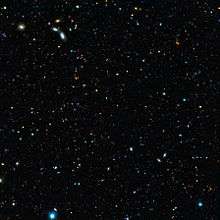Great Observatories Origins Deep Survey
The Great Observatories Origins Deep Survey or GOODS is an astronomical survey combining deep observations from three of NASA's Great Observatories: the Hubble Space Telescope, the Spitzer Space Telescope , and the Chandra X-ray Observatory, along with data from other space-based telescopes, such as XMM Newton, and some of the worlds most powerful ground-based telescopes.
GOODS is intended to enable astronomers to study the formation and evolution of galaxies in the distant, early, universe.
.jpg)
The Great Observatories Origins Deep Survey consists of optical and near-infrared imaging taken with the Advanced Camera for Surveys on the Hubble Space Telescope, the Very Large Telescope and the 4-m telescope at Kitt Peak National Observatory; infrared data from the Spitzer Space Telescope. These are added to pre-existing x-ray data from the Chandra X-ray Observatory and ESAs XMM-Newton, two fields of 10' by 16'; one centered on the Hubble Deep Field North (12h 36m 55s, +62° 14m 15s) and the other on the Chandra Deep Field South (3h 32m 30s, -27° 48m 20s).
The two GOODS fields are the most data-rich areas of the sky in terms of depth and wavelength coverage.
Instruments

GOODS consists of data from the following space-based observatories:
- The Hubble Space Telescope (optical imaging with the Advanced Camera for Surveys)
- The Spitzer Space Telescope (infrared imaging)
- The Chandra X-Ray Observatory (X-ray)
- XMM-Newton (an X-ray telescope belonging to the European Space Agency)
- The Herschel Space Observatory (an infrared telescope belonging to the ESA)
Hubble Space Telescope images
GOODs used the Hubble Space Telescope's Advanced Camera for Surveys with four filters, centered at 435, 606, 775 and 850 nm. The resulting map covers 30 times the area of the Hubble Deep Field to a photometric magnitude less sensitivity, and has enough resolution to allow the study of 1 kpc-scale objects at redshifts up to 6. It also provides photometric redshifts for over 60,000 galaxies within the field, providing an excellent sample for studying bright galaxies at high redshifts.[1]
Herschel
In May 2010, scientists announced that the infrared data from the Herschel Space Observatory was joining the GOODS dataset, after initial analysis of data using Herschel's PACS and SPIRE instruments. In October 2009, Herschel observed the GOODS-North field, and in January 2010 the GOODS-South field. In so doing, Herschel identified sources for the Cosmic Infrared Background.[2]
Gallery
-

GOODS field containing distant dwarf galaxies.[1]
-

GOODS South Field.[2]
-

Galaxy NTTDF-474 is one of five that have been used to chart the timeline of the reionisation of the Universe.[3] Image taken by ESO's Very Large Telescope.
-

Galaxy NTTDF-6345 is one of five that have been used to chart the timeline of the reionisation of the Universe.[3] Image taken by ESO's Very Large Telescope.
- ^ "Small but significant". ESA/Hubble Press Release. Retrieved 19 June 2014.
- ^ "Hubble Uncovers Tiny Galaxies Bursting with Starbirth in Early Universe". ESA/Hubble Press Release. Retrieved 14 November 2011.
- ^ a b "Distant Galaxies Reveal The Clearing of the Cosmic Fog". ESO Science Release. Retrieved 12 October 2011.
References
- ↑ Giavalisco, M.; et al. (2004). "The Great Observatories Origins Deep Survey: Initial Results from Optical and Near-Infrared Imaging". The Astrophysical Journal. 600 (2): 93–98. arXiv:astro-ph/0309105
 . Bibcode:2004ApJ...600L..93G. doi:10.1086/379232.
. Bibcode:2004ApJ...600L..93G. doi:10.1086/379232. - ↑ Herschel Reveals Galaxies In The GOODS Fields In A Brand New Light, spacedaily.com, 12 May 2009, accessed 13 May 2009
External links
- GOODS Homepage
- NASA Image of the Day Gallery January 7, 2010 - History Revealed - More than 12 billion years of cosmic history are shown in this panoramic, full-color view of thousands of galaxies.
- ESOcast 21: The Great Observatories Origins Deep Survey (GOODS).